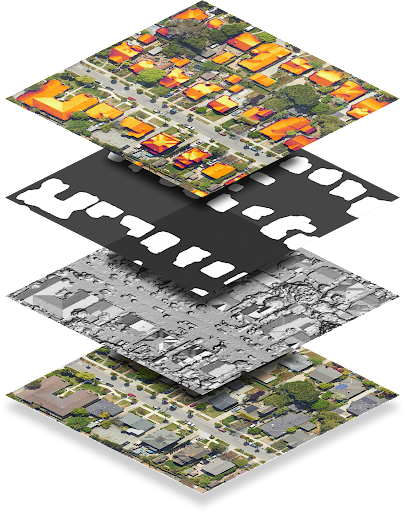
تعرض نقطة النهاية dataLayers بيانات مرمّزة كملفات GeoTIFF، ويمكن استخدامها في أي تطبيق لنظام المعلومات الجغرافية (GIS) لتصميم أنظمة الطاقة الشمسية.
يحتوي كل سلسلة في استجابة dataLayers على عنوان URL يمكنك استخدامه لجلب ملف GeoTIFF المقابل. تكون عناوين URL صالحة لمدة تصل إلى ساعة واحدة بعد إنشائها من طلب طبقات البيانات الأصلي. يمكن تخزين ملفات GeoTIFF لمدة تصل إلى 30 يومًا.
باستثناء طبقة RGB، لا يتم عرض ملفات GeoTIFF بشكل صحيح باستخدام عارض الصور، لأنّ المحتوى هو بيانات مرمّزة وليس صور RGB. لا يمكن أيضًا استخدام ملفات GeoTIFF مباشرةً كصورة تراكب مع Maps JavaScript API.
يوضّح الجدول التالي كل طبقة بالتفصيل.
| طبقة | عمق البكسل | الدقة | الوصف |
|---|---|---|---|
| نموذج السطح الرقمي (DSM) | قيمة عائمة 32 بت | 0.1 متر/بكسل | بيانات الارتفاع التي تمثّل تضاريس سطح الأرض، بما في ذلك العناصر الطبيعية والمبنية تكون القيم بالأمتار فوق مستوى سطح البحر. يتم تخزين المواقع الجغرافية غير الصالحة أو المناطق التي لا تتوفّر لدينا بيانات عنها بالقيمة -9999. |
| RGB | 8 بت | 0.1 متر/بكسل 0.25 متر/بكسل |
صورة جوية أو صورة قمر صناعي للمنطقة يحتوي ملف صور GeoTIFF على ثلاث نطاقات تتوافق مع قيم الأحمر والأخضر والأزرق بالترتيب لتكوين قيمة RGB ذات 24 بت لكل بكسل. تبلغ دقة البكسل تلقائيًا 0.1 متر/بكسل. |
| قناع المبنى | 1 بت | 0.1 متر/بكسل | بت واحد لكل بكسل يشير إلى ما إذا كان يتم اعتبار هذا البكسل جزءًا من سطح أحد المباني. |
| التدفق السنوي | قيمة عائمة 32 بت | 0.1 متر/بكسل | خريطة التدفق السنوي أو أشعة الشمس السنوية على الأسطح في المنطقة
القيم هي كيلوواط ساعة/كيلوواط/السنة. يتم احتساب معدّل التدفق لكل موقع جغرافي، وليس فقط لأسطح المباني. يتم تخزين المواقع الجغرافية غير الصالحة أو المناطق التي لم نتمكّن من احتساب معدل التغيّر فيها بالقيمة -9999. المواقع الجغرافية خارج نطاق التغطية غير صالحة. ملاحظة: هذا هو التدفق غير المخفي. |
| التدفّق الشهري | قيمة عائمة 32 بت | 0.5 متر/بكسل | خريطة التدفق الشهري (ضوء الشمس على الأسطح، مقسّمًا حسب الشهر) للمنطقة القيم هي كيلوواط ساعة/كيلوواط/السنة. يحتوي ملف صور GeoTIFF على 12 نطاقًا تتوافق مع الأشهر من كانون الثاني (يناير) إلى كانون الأول (ديسمبر)، بالترتيب. |
| الظل كل ساعة | عدد صحيح 32 بت | متر واحد لكل بكسل | 12 عنوان URL لخرائط الظل كل ساعة، تتوافق مع الفترة من يناير إلى ديسمبر، بالترتيب يحتوي كل ملف GeoTIFF على 24 نطاقًا تتوافق مع 24 ساعة في اليوم. كل بكسل هو عدد صحيح 32 بت، ويتوافق مع (ما يصل إلى) 31 يومًا من ذلك الشهر. يشير الرقم 1 إلى أنّ الموقع الجغرافي المعنيّ يمكنه رؤية الشمس في ذلك اليوم وفي تلك الساعة من ذلك الشهر. يتم تخزين المواقع الجغرافية غير الصالحة بالقيمة -9999 ويتم ضبط البت 31، لأنّ ذلك يتوافق مع اليوم الثاني والثلاثين من الشهر وبالتالي يكون غير صالح. |
فك ترميز بيانات نقطية خاصة بالظل كل ساعة
يتم ترميز بيانات الظل بالساعة في بيانات نقطية متعددة النطاقات. لمزيد من المعلومات حول أساسيات الصور النقطية، يُرجى الاطّلاع على مفاهيم Solar API.
عند تقديم طلب للحصول على بيانات الظل كل ساعة، يمكنك تلقّي ما يصل إلى 12 صورة نقطية، واحدة لكل شهر من السنة التقويمية (من كانون الثاني/يناير إلى كانون الأول/ديسمبر). يتألف كل صورة نقطية من 24 طبقة، أو نطاقًا، تتوافق مع 24 ساعة في اليوم.
يتم تمثيل كل نطاق بمصفوفة من الخلايا أو وحدات البكسل. يحتوي كل بكسل على عمق 32 بت، وهو ما يتوافق مع (الحد الأقصى) 31 يومًا من الشهر. لذلك، يتطلّب فك ترميز بيانات الظل حسب اليوم والوقت والشهر فهم البت والنطاق والصورة النقطية التي تحلّلها.
على سبيل المثال، لتحديد ما إذا كان موقع جغرافي معيّن بالإحداثيات (س، ص) قد شهد الشمس في الساعة 4:00 مساءً يوم 22 يونيو، اتّبِع الخطوات التالية:
- إرسال طلب طبقات بيانات لجميع الطبقات الخاصة بالموقع الجغرافي (س، ص)
- بما أنّ شهر يونيو هو الشهر السادس من السنة، يجب استرداد عنوان URL السادس في القائمة
hourlyShadeUrls. - يتم عرض النطاقات الزمنية بالساعة بتنسيق الوقت المكوّن من 24 ساعة. للحصول على بيانات الساعة 4:00 مساءً (16:00)، ابحث عن القناة رقم 17.
- فهرس البتات (الأيام) الذي يبدأ من 0 للحصول على بيانات اليوم الثاني والعشرين من يونيو، اقرأ البت رقم 21.
- توفّر وحدات البت بيانات ثنائية تشير إلى ما إذا كان الموقع الجغرافي قد شهد شروق الشمس في التاريخ والوقت المحدّدين. إذا كانت القيمة 1، يعني ذلك أنّ الموقع الجغرافي شهد شروق الشمس. إذا كانت قيمة البت 0، يعني ذلك أنّ الموقع الجغرافي شهد ظلًا.
يلخّص الرمز البرمجي التالي الخطوات المذكورة أعلاه:
(hourly_shade[month - 1])(x, y)[hour] & (1 << (day - 1))

